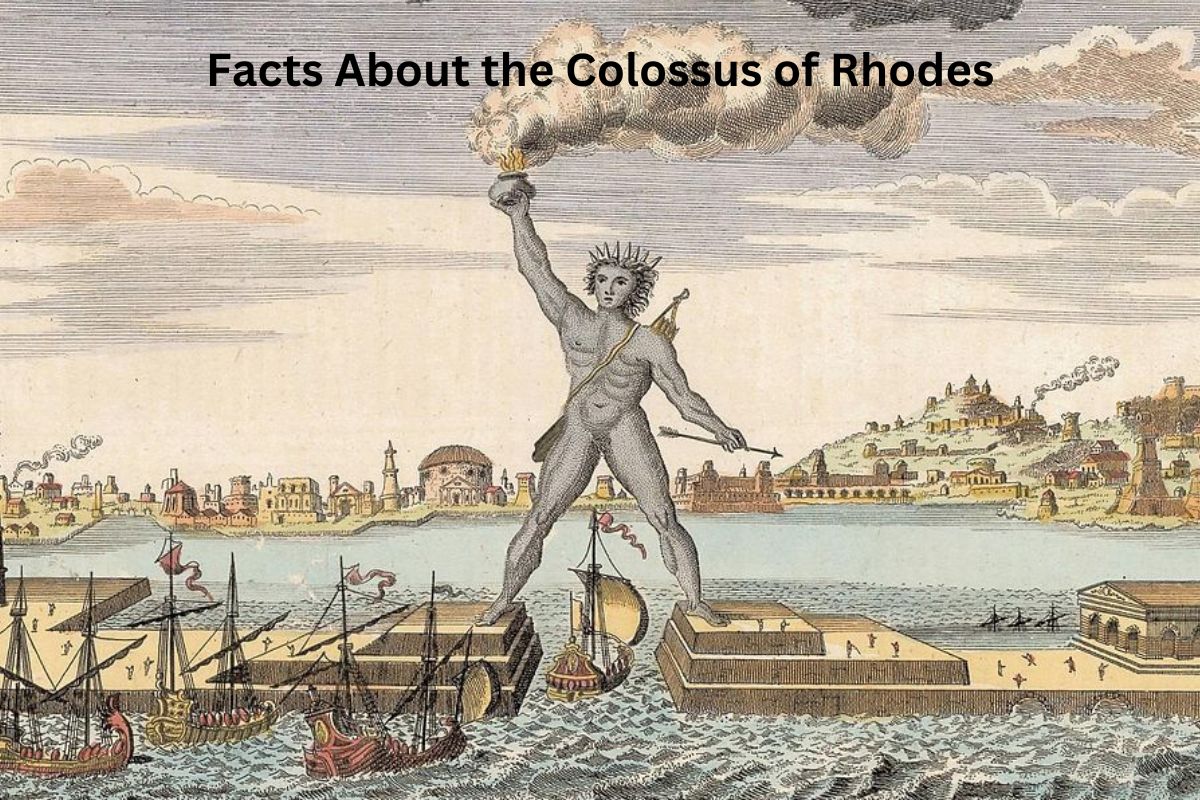The Colossus of Rhodes was an awe-inspiring statue of the Greek god Helios, constructed on the Greek island of Rhodes in the 3rd century BC. It stood at an impressive height of approximately 33 meters (108 feet), making it one of the tallest statues of the ancient world.
Positioned at the entrance of the harbor, the Colossus symbolized the city’s power and maritime prominence. Unfortunately, it met a tragic fate when an earthquake in 226 BC caused its collapse.
Although the remains were admired by visitors for centuries, they were eventually sold off and melted down.
Today, the Colossus of Rhodes exists only in historical accounts, artistic reconstructions, and the imagination of people.
The Colossus of Rhodes Facts
1. It was a gigantic statue of the Greek god Helios
The Colossus of Rhodes was a massive sculpture representing the god Helios, who was associated with the sun in Greek mythology.
Also Read: Hanging Gardens of Babylon Facts
Helios was depicted as a majestic figure, often portrayed with a radiant crown and a chariot pulled by four horses. The statue aimed to honor and pay tribute to this deity.
2. The statue was built between 292 and 280 BC
The construction of the Colossus of Rhodes took place during the period between 292 and 280 BC. It was commissioned to celebrate the victory of Rhodes over the army of Demetrius Poliorcetes, a general and king of Macedon. The statue also served as a symbol of the city’s independence and power.
3. It stood at a height of approximately 33 meters (108 feet)
The Colossus of Rhodes was renowned for its immense size and height. It stood at an estimated height of around 33 meters (108 feet), making it one of the tallest statues of the ancient world.
The sheer magnitude of the statue made it an awe-inspiring sight for those who beheld it, symbolizing the grandeur and magnificence of Rhodes.
4. The Colossus was made of bronze
The construction of the Colossus involved using a framework made of iron and stone to provide structural support. The outer layer, which gave the statue its distinct appearance, was crafted from bronze.
Also Read: Ancient Wonders of the World
Bronze, an alloy of copper and tin, was a popular material for statues during that time due to its durability and aesthetic appeal. The bronze plates were attached to the internal framework, forming the outer skin of the statue.
This bronze exterior added a lustrous and captivating quality to the Colossus, enhancing its grandeur and making it a magnificent sight to behold.
5. It stood at the entrance of the harbor of Rhodes
The Colossus of Rhodes was strategically positioned at the entrance of the harbor of Rhodes, one of the main ports in the eastern Mediterranean during ancient times.
It was constructed with its legs on either side of the harbor’s entrance, creating a majestic and imposing gateway for ships arriving at the island.
This placement not only showcased the statue’s grandeur but also symbolized the city’s maritime significance and prowess.
6. It was constructed in pieces and then assembled on-site
To build the Colossus, the statue was constructed in sections, or pieces, and then assembled on-site. The internal structure of the statue was made using iron and stone to provide stability and support.
The outer skin of the statue was created by attaching bronze plates to the framework, giving it a visually striking appearance. Skilled craftsmen and workers collaborated to meticulously construct and assemble the various components of the statue.
7. The statue was destroyed by an earthquake in 226 BC
Despite its initial splendor, the Colossus of Rhodes endured a relatively short existence. In 226 BC, a powerful earthquake struck the island of Rhodes, toppling the statue and causing it to break at the knees.
The force of the earthquake and subsequent collapse led to the statue’s destruction. The event became a significant historical moment, marking the end of the Colossus and leaving behind the fallen remains of the once-majestic statue.
8. The remains of the Colossus lay on the ground for centuries
Following the devastating earthquake that toppled the Colossus, the fallen remains of the statue lay on the ground for an extended period of time.
Historical accounts suggest that people from far and wide would visit Rhodes to witness the remnants of the colossal sculpture, marveling at its immense size and the spectacle of its ruin.
9. The statue’s bronze was eventually sold and reused
After lying in ruins for several centuries, Rhodes was invaded by different armies over time. It is believed that the conquerors sold off the remains of the Colossus, likely the bronze components, for their considerable value.
The bronze was likely melted down and repurposed for other purposes, erasing the physical traces of the once-majestic statue.
10. No physical remains of the Colossus have been found
Regrettably, no physical remains of the Colossus of Rhodes have been discovered to date. Despite various theories and attempts to locate fragments or artifacts related to the statue, its exact location and remnants remain uncertain.
The absence of tangible evidence has given rise to artistic reconstructions and imaginative depictions of the Colossus, perpetuating its memory through historical accounts and artistic interpretations.
